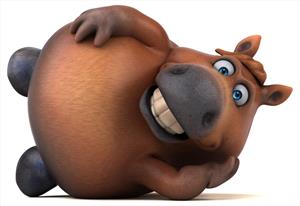fat horse cartoon

While I’m not yet an old grey mare, I do have one thing in common with the older horse. My metabolism ain’t what it used to be.
I’m afraid to stand still in my house. I have teenagers, and I’m pretty sure if I don’t move around frequently, they’ll mistake me for something edible. They consume entire pots of chili. Pounds of chicken disappear; ice cream and salads alike are inhaled. Yet, the ravenous locusts masquerading as my offspring never seem to change shape. Meanwhile, I’m pretty sure this morning’s coffee cake is peeking out over the waistband of my slacks to say hi to my toes.
Ah, well.
Previously on Old Horses at Home, our heroes delved into the depths of the oral cavity, exploring the dental adventures of the aging horse.
But teeth are just the beginning of caring for the… ahem… mature equine.
As mammals age, nutritional requirements change, as does the body’s handling capacity for certain nutrients.
Just like us, horses can’t eat like college students forever. And just like us, they change shape as their metabolisms change.
The shaggy, pot-bellied horse with hollowed hips and bony back may not look it, but she is related to the sleek “easy keeper” with the magnificent butt dimples.
Both most likely have age-related metabolic disorders
As they age, some horses are more likely to become resistant to insulin, causing them to pack on the pounds.
If your horse’s neck looks like an ancient statue of a Chinese war horse, and you can sail a small boat down the water that collects in the trough between his butt cheeks, there’s a decent possibility he has equine metabolic syndrome (EMS).
EMS horses don’t properly process sugars, making them likely to gain weight “on air.” Your veterinarian can test your horse’s blood glucose and insulin levels and make feeding recommendations, but in general, with these…um…voluptuous equines, it’s best to stay away from high carbohydrate feeds such as grains and lush grass.
Excessive weight in horses, like in people, can increase stress on arthritic joints. Additionally, improper sugar metabolism makes horses prone to developing laminitis. So even though your horse’s plumpness may look pleasing, check with your veterinarian to see how much padding is too much.
On the flip side, we have the horse who loses pounds, looking progressively more zombie-like as winter wears on despite ample amounts of hay and grain.
One of the first places to look is the teeth. As we discussed before during our dental adventure, sometimes horses simply run out of tooth and are unable to properly grind their food. These horses seem to spend more energy trying to digest their food than they get from it. Hay can ball up in their intestines or even in the throat and cause blockages. One way to get an idea of how well your horse is chewing his food is to take a look at what comes out the other end. If there are long strands of hay or chunks of whole grain in the manure, that can be a sign that he’s not getting the calories he needs from dinner.
Feeding a senior complete feed (pelleted diet) can help these horses, but it’s a good idea to get your vet out to have your horse say “AAAAHHHH” and donate a few tubes of blood for science.
Bloodwork can help rule out other causes of weight loss, such as liver or kidney disease. It can also be used to look for signs of infection or cancer.
Skinny old horses may also benefit from extra calories in the form of fat: flax, corn oil, or commercial supplements work.
Think of feeding the old horse as like feeding a teenage human. Be prepared to ramp up the food budget and adapt to rapidly changing needs.